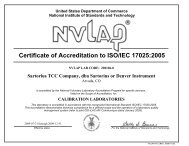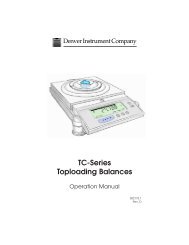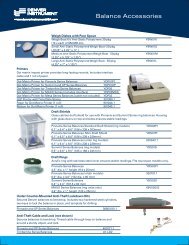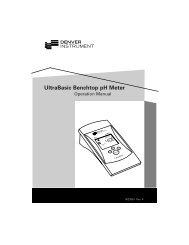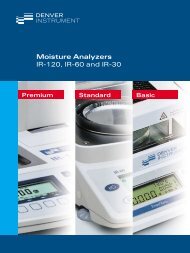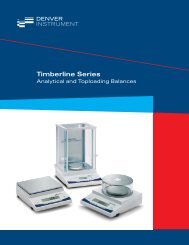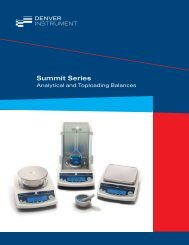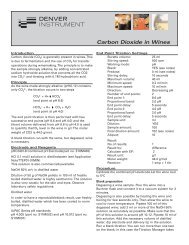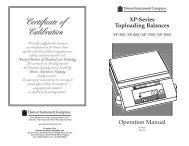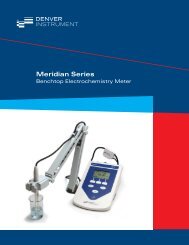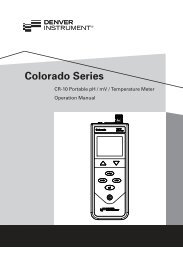Titratable Acidity and Formol Number in Fruit Juices - Denver ...
Titratable Acidity and Formol Number in Fruit Juices - Denver ...
Titratable Acidity and Formol Number in Fruit Juices - Denver ...
You also want an ePaper? Increase the reach of your titles
YUMPU automatically turns print PDFs into web optimized ePapers that Google loves.
<strong>Titratable</strong> <strong>Acidity</strong> <strong>and</strong> <strong>Formol</strong> <strong>Number</strong> <strong>in</strong> <strong>Fruit</strong> <strong>Juices</strong><br />
Introduction<br />
The formol number, or formol titration, measures the<br />
total am<strong>in</strong>o acid (NH 2 -R-COOH) concentration. Us<strong>in</strong>g 2<br />
successive end po<strong>in</strong>t titrations, it is possible to<br />
determ<strong>in</strong>e total titratable acidity <strong>and</strong><br />
formol number.<br />
Pr<strong>in</strong>ciple<br />
The determ<strong>in</strong>ation of formol number takes place <strong>in</strong><br />
three steps:<br />
1) Neutralisation of titratable acidity by means of an<br />
end po<strong>in</strong>t titration at pH 8.2 with NaOH 0.1 eq/l<br />
2) Addition of an excess of formol (HCHO) to the<br />
solution. This operation locks the NH2 groups of am<strong>in</strong>o<br />
acids due to the decrease <strong>in</strong> pH <strong>and</strong> allows titration of<br />
the COOH groups of am<strong>in</strong>o acids with an end po<strong>in</strong>t<br />
titration at pH 8.2<br />
3) Second endpo<strong>in</strong>t titration at pH 8.2 to determ<strong>in</strong>e<br />
total am<strong>in</strong>o acid content. The result is then expressed<br />
as milliequivalents/100 ml or milliequivalent/l<br />
Electrode <strong>and</strong> Reagents<br />
pHC2401-8 Comb<strong>in</strong>ed pH Electrode (part no. E16M400)<br />
NaOH 0.1 eq/l solution <strong>in</strong> distilled water (see separate<br />
application note)<br />
Distilled water<br />
Check the pH of the distilled water. Us<strong>in</strong>g the titration<br />
manager as a pH meter, adjust the distilled water to pH<br />
8.2, by means of few drops of base or acid solution,<br />
with NaOH 0.1 as titrant<br />
<strong>Formol</strong> (HCHO) solution at 37% adjusted to pH 8.2<br />
IUPAC Series pH st<strong>and</strong>ards<br />
pH 4.005 (part no. S11M002) or pH 7.000 (part no.<br />
S11M004) <strong>and</strong> pH 10.012 (part no. S11M007)<br />
End Po<strong>in</strong>t titration sett<strong>in</strong>gs<br />
Two l<strong>in</strong>ked methods<br />
First method (can be used as titratable acidity)<br />
Burette volume:<br />
10 ml<br />
Maximum volume:<br />
30 ml<br />
Stirr<strong>in</strong>g speed:<br />
400 rpm<br />
Work<strong>in</strong>g mode:<br />
pH<br />
<strong>Number</strong> of end po<strong>in</strong>ts: 1<br />
End po<strong>in</strong>t:<br />
8.20 pH<br />
Stirr<strong>in</strong>g delay:<br />
30 seconds<br />
M<strong>in</strong>imum speed:<br />
0.2 ml/m<strong>in</strong><br />
Maximum speed:<br />
10 ml/m<strong>in</strong><br />
Proportional b<strong>and</strong>:<br />
3.00 pH<br />
End po<strong>in</strong>t delay:<br />
10 seconds<br />
Sample unit:<br />
ml<br />
Sample amount: 10<br />
Result expression:<br />
g/l<br />
(of tartaric acid<br />
or citric acid)<br />
Titration:<br />
Increas<strong>in</strong>g pH<br />
Second method (<strong>Formol</strong> number determ<strong>in</strong>ation)<br />
Burette volume:<br />
10 ml<br />
Maximum volume:<br />
10 ml<br />
Stirr<strong>in</strong>g speed:<br />
400 rpm<br />
Work<strong>in</strong>g mode:<br />
pH<br />
<strong>Number</strong> of end po<strong>in</strong>ts: 1<br />
End po<strong>in</strong>t:<br />
8.20 pH<br />
Stirr<strong>in</strong>g delay:<br />
60 seconds<br />
M<strong>in</strong>imum speed:<br />
0.2 ml/m<strong>in</strong><br />
Maximum speed:<br />
5 ml/m<strong>in</strong><br />
Proportional b<strong>and</strong>:<br />
2.00 pH<br />
End po<strong>in</strong>t delay:<br />
10 seconds<br />
Sample unit:<br />
ml<br />
Sample amount: 10<br />
Result expression:<br />
meq/100 ml<br />
Titration:<br />
Increas<strong>in</strong>g pH<br />
Procedure<br />
Connect the electrode to the electrode <strong>in</strong>put.<br />
Calibrate the electrode us<strong>in</strong>g the two IUPAC st<strong>and</strong>ards<br />
above.<br />
Stir <strong>and</strong> pipette 10 ml of sample.<br />
Always dilute the sample with the same volume of<br />
distilled water (25 ml for example).<br />
Dip electrode <strong>and</strong> delivery tip <strong>in</strong> the solution<br />
Start titration by press<strong>in</strong>g the RUN key.<br />
At the end of the first method manually add 5 ml of<br />
HCHO solution for 10 ml of sample to the<br />
sample solution.<br />
Results<br />
For titratable acidity expressed as g/l of tartaric acid<br />
(HOOC-(CHOH) 2 -COOH)<br />
Result is normally expressed as g/l of tartaric acid<br />
(MW= 150.09 g/mol <strong>and</strong> 2 acid functions).
As 2 molecules of NaOH react with 1 molecule of<br />
tartaric acid:<br />
R = V(titr) * C(titr) * 150.09 / V(smp) * 2<br />
-V(titr) = total volume of titrant to reach the end<br />
po<strong>in</strong>t <strong>in</strong> ml<br />
-C(titr) = Titrant concentration <strong>in</strong> eq/l (currently<br />
0.1)<br />
-V(smp) = sample volume150.09 = molecular<br />
weight of tartaric acid<br />
2 = Ratio between titrant <strong>and</strong> sample<br />
For titratable acidity <strong>in</strong> g/l of tartaric acid<br />
Enter <strong>in</strong> the first method<br />
The actual sample amount <strong>in</strong> the SAMPLE screen <strong>in</strong> ml<br />
The titrant concentration <strong>in</strong> the TITRANT screen <strong>in</strong><br />
mol/l or eq/l<br />
2 Titrants <strong>and</strong> 1 Sample <strong>in</strong> theCOEFFICIENTS display<br />
150.09 as molecular weight<br />
The Titration Manager gives a result accord<strong>in</strong>g the<br />
above formula.<br />
For titratable acidity <strong>in</strong> g/l of citric acid (that has 3 acid<br />
functions with a MW of 192.4)<br />
Enter <strong>in</strong> the first method<br />
The actual sample amount <strong>in</strong> the SAMPLE screen <strong>in</strong> ml<br />
The titrant concentration <strong>in</strong> the TITRANT screen <strong>in</strong><br />
mol/l or eq/l<br />
3 Titrants <strong>and</strong> 1 Sample <strong>in</strong> the COEFFICIENTS display<br />
192.4 as molecular weight<br />
The Titration Manager gives a result accord<strong>in</strong>g the<br />
above formula.<br />
For <strong>Formol</strong> number expressed as meq/l<br />
<strong>Formol</strong> no. = V(titr) * C(Titr) *1000/ V(smp)<br />
-V(titr) = total volume of titrant to reach the end po<strong>in</strong>t<br />
<strong>in</strong> ml<br />
-C(titr) = Titrant concentration <strong>in</strong> eq/l or mol/l (currently<br />
0.1)<br />
-V(sample) = sample volume <strong>in</strong> ml<br />
For formol number <strong>in</strong> meq/100ml<br />
Enter <strong>in</strong> the second method<br />
The actual sample amount <strong>in</strong> the SAMPLE screen <strong>in</strong> ml<br />
The titrant concentration <strong>in</strong> the TITRANT screen <strong>in</strong><br />
mol/l or eq/l<br />
1 Titrant <strong>and</strong> 1 Sample <strong>in</strong> the COEFFICIENTS display (if<br />
necessary)<br />
Enter <strong>in</strong> the RESULT screen<br />
Result: 1<br />
Unit:<br />
eq/l<br />
Equation: 1<br />
Formula: R1/10<br />
Name: meq/100 ml<br />
The Titration Manager gives 2 results:<br />
Result expressed <strong>in</strong> meq/l<br />
Result from equation formula, expressed <strong>in</strong> meq/100<br />
ml<br />
3 determ<strong>in</strong>ations on grapefruit juice<br />
<strong>Acidity</strong><br />
Mean:<br />
15.28 g/l tartaric acid<br />
St<strong>and</strong>ard deviation:<br />
0.02 g/l tartaric acid<br />
Rel. st<strong>and</strong>ard deviation: 0.13%<br />
<strong>Formol</strong> number<br />
Mean:<br />
2.19 meq/100 ml<br />
St<strong>and</strong>ard deviation:<br />
0.038 meq/100 ml<br />
Rel. st<strong>and</strong>ard deviation: 1.7%<br />
Work<strong>in</strong>g Range<br />
Related to the calculation formula, us<strong>in</strong>g 10 ml for<br />
sample volume <strong>and</strong> 0.1 eq/l titrant concentration. For<br />
acidity determ<strong>in</strong>ation 1 ml of titrant corresponds to<br />
0.75 g/l of tartaric acid.<br />
For formol number determ<strong>in</strong>ation:<br />
<strong>Formol</strong> no. (meq/100 ml) = V(titr) <strong>in</strong> ml<br />
For a 10 ml burette, formol number range can be<br />
estimated between 0.2 (experimental low limit<br />
correspond<strong>in</strong>g to 0.2 ml) <strong>and</strong> 10 (nom<strong>in</strong>al value of<br />
cyl<strong>in</strong>der capacity):<br />
<strong>Formol</strong> no. (meq/l) = <strong>Formol</strong> no. (meq/100 ml) * 10<br />
Notes<br />
Depend<strong>in</strong>g on local procedures, the first end po<strong>in</strong>t can<br />
vary between pH 8.0 <strong>and</strong> pH 8.4.<br />
The most commonly used value is pH 8.2. We use this<br />
value <strong>in</strong> this application.<br />
It is also possible to have different values for the pH<br />
end po<strong>in</strong>ts (for example, pH 8.1 for the first <strong>and</strong><br />
pH 8.4 for the second).<br />
Adjust the pH of the formol solution to the same value<br />
as that used <strong>in</strong> the second end po<strong>in</strong>t titration (formol<br />
number determ<strong>in</strong>ation).




